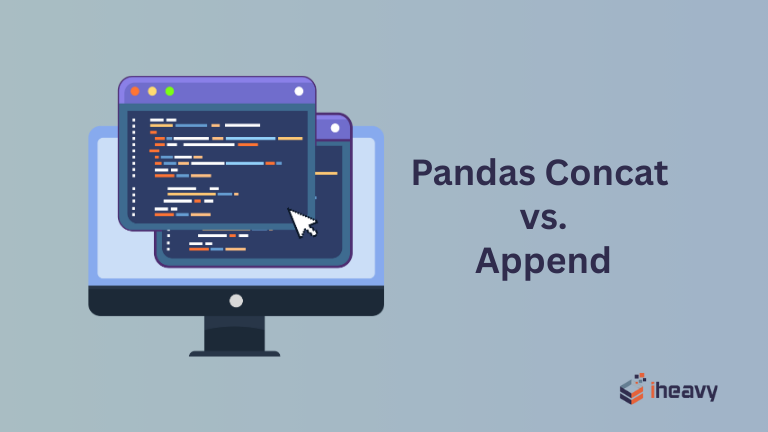Pandas Concat vs. Append: A Comparative Guide
Pandas is a powerful and flexible Python library widely used for data manipulation and analysis. Two fundamental operations in pandas for combining DataFrames are concat and append. While they might seem similar, they have distinct use cases and functionalities.
This article aims to elucidate the differences between concat and append, providing clear examples to help you decide which method to use in your data manipulation tasks.
What is concat?
The concat function in pandas is a versatile method for concatenating multiple DataFrames along a particular axis. It can be used to combine DataFrames vertically (along rows) or horizontally (along columns).
Syntax
pandas.concat(objs, axis=0, join='outer', ignore_index=False, keys=None, levels=None, names=None, verify_integrity=False, sort=False, copy=True)Parameters
- objs: A list or dictionary of pandas objects (DataFrames or Series) to concatenate.
- axis: The axis to concatenate along (0 for rows, 1 for columns).
- join: Determines how to handle indexes on other axes. Options are ‘outer’ (union of indexes) and ‘inner’ (intersection of indexes).
- ignore_index: If True, the resulting DataFrame will have a new integer index.
- keys: Used to create a hierarchical index.
- verify_integrity: Checks for duplicate indexes.
- sort: Sort the data in each axis.
Examples
Concatenating Vertically:
import pandas as pd
df1 = pd.DataFrame({'A': [1, 2], 'B': [3, 4]})
df2 = pd.DataFrame({'A': [5, 6], 'B': [7, 8]})
result = pd.concat([df1, df2])
print(result)Output:
A B
0 1 3
1 2 4
0 5 7
1 6 8
Concatenating Horizontally:
result = pd.concat([df1, df2], axis=1)
print(result)Output:
A B A B
0 1 3 5 7
1 2 4 6 8
What is append?
The append method in pandas is specifically designed for appending rows of one DataFrame to another. It is a more straightforward method when you need to add new rows to an existing DataFrame.
Syntax
DataFrame.append(other, ignore_index=False, verify_integrity=False, sort=False)Parameters
- other: The DataFrame or Series to append.
- ignore_index: If True, the resulting DataFrame will have a new integer index.
- verify_integrity: Checks for duplicate indexes.
- sort: Sort the data in each axis.
Example
result = df1.append(df2)
print(result)Output:
A B
0 1 3
1 2 4
0 5 7
1 6 8
What is the difference between append and concat in pandas?
Here is a table summarizing the key differences between pandas.concat and pandas.append:
| Feature | pandas.concat | pandas.append |
| Functionality | Combines DataFrames along both rows and columns | Specifically for appending rows to a DataFrame |
| Syntax | pd.concat(objs, axis=0, join=’outer’, ignore_index=False, keys=None, levels=None, names=None, verify_integrity=False, sort=False, copy=True) | df.append(other, ignore_index=False, verify_integrity=False, sort=False) |
| Axis | Can concatenate along both axis=0 (rows) and axis=1 (columns) | Only appends along axis=0 (rows) |
| Performance | More efficient for large datasets, especially with multiple objects | Slower for large datasets |
| Flexibility | High, with options like keys, levels, and join | Less flexible, with fewer parameters |
| Use Cases | Complex combinations, requiring control over structure | Quick row additions |
| Index Handling | Can control index with ignore_index and keys | Simple index handling with ignore_index |
| Join Options | Supports join parameter to handle indexes (outer or inner) | Does not support join options |
| Hierarchical Index | Can create a hierarchical index with keys | Cannot create hierarchical index |
| Parameter Count | More parameters for extensive customization | Fewer parameters, simpler to use |
Frequently Asked Questions
Why is append faster than concat?
Both methods are relatively fast, but their speed can vary slightly depending on the dataset. The `append` function adds rows from the second DataFrame to the first one row by row. In contrast, the `concat` function performs the operation in one go, making it generally faster than `append`.
Is append in pandas deprecated?
The `append` method is deprecated and will be removed from pandas in a future version. It is recommended to use `pandas.concat` instead.
Conclusion
Both concat and append are essential tools in the pandas library, each serving distinct purposes. You can use concat for more complex combinations and flexibility, and append for straightforward row additions. By leveraging these methods effectively, you can streamline your data processing workflows and achieve better performance in your data analysis tasks.






